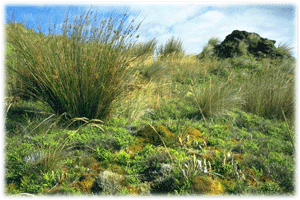|
The existing flora presents a clearly marked type of vegetation-levels
according to the altitude.
- The short-grown meadow makes a belt round the island, only
broken off by the high cliffs of Entrecasteaux in the South-West.
It streches out from the coast up to about 250 metres high except
in the South south-eastern part where it stops at about 100 m
high.
The vegetation there mainly consists of slow-growing autochtonous
plants -the bulrush (Scirpus aucklandicus) - as well as introduced
plants such as the holcus (Holcus lanatus - velvet soft meadow
grass) and the taraxacum (Leontodon taraxacoides - dandelion)
which both put up with the trampling and grazing of cattle. Recently
introduced, the cirsium (Cirsium vulgare - thistle) has greatly
extended since the 1974 fire.
- The transitional zone streches above the short-grown meadow
up to about 350 m above sea level. It is mainly composed of rushes
(Juncus effusus) and of club-rushes (Scirpus nodosus) along with
bulrushes (Scirpus aucklandicus) and little ferns Blechnum penna-marina.
The residual area of phylica trees (Phylica nitida) streches
out on the eastern slope between the "Grand Bois" (large
forest) and the "Chaudron" (the cauldron).
- The cryptogamic vegetation is located on the upper level
and up to 500 m high. The steep slopes are mainly planted with
ferns Gleichenia polypodioides (polypods). The gentler
slopes are planted with ferns Etaphoglossum succaessifolium ,
Blechnum penna-marina and varied moss.
- The slopy peat-bog streches up to about 700 m high and is
called " Plateau des Tourbieres " (peat-bog plateau).
The peaty soil favours the development of moss, sphagums and
a few graminaceae such as Poa fuegiania.
- The swampy peat-bog is located inside La Dives calderia
and in a few zones of the " Plateau des Tourbieres ".
It is nearly exclusively composed of moss, sphaga and hepaticae.
 Leontodon taraxacoides
Leontodon taraxacoides |
 Gleichenia polypodioides
Gleichenia polypodioides |
 Poa fuegiania
Poa fuegiania |
 Typical vegetation at 250 m high
Typical vegetation at 250 m high |